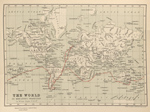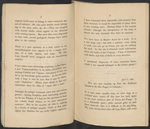Sailing Towards the Origin
Charles Darwin launched on a journey around the world as a naturalist on the H.M.S. Beagle in 1831. He was twenty-two years old. While his primary interests on the voyage were geological and paleontological, he also collected a wide range of animal and plant specimens which he sent back to England for description. The observations made during the voyage are forever present in his later writings, including those published after the Origin of Species appeared in 1859.
— Charles Darwin
 |
H.M.S. Beagle, early 19th century. Scale model by Louis Audette. [zoom] | Additional images:     
The H.M.S Beagle was originally built as one of a large class of ten-gun brigs for the British Navy, and was first launched in 1820. She was re-fitted and re-rigged three times as a survey vessel. This model is based on the 1831 (second) refit by Robert FitzRoy, Darwin’s captain on the famous voyage. Because the Beagle was a commissioned ship of the line, the Admiralty required it to be armed, but allowed its cannons to be made of brass (a metal which would not interfere with the compasses). The ship carried up to seventy-three men, and more workboats than are included on this model, as they would have obscured much of the deck detail. On loan from Louis Audette. |
 |
Charles Darwin. Journal of Researches into the Natural History and Geology of the Countries Visited during the Voyage round the World of the H.M.S. “Beagle”…. New York: Appleton, 1890. [zoom] The H.M.S. Beagle sailed first to South America, the continent which Darwin explored most fully during the voyage. The surveying vessel charted much of the South American coastline, allowing Darwin also to explore the jungle, pampas, and cordillera on horseback and foot. |
 |
Charles Darwin. Extracts from Letters Addressed to Professor Henslow, Read at a Meeting of the Cambridge Philosophical Society, 16 November, 1835. Cambridge, Eng.: Privately printed, 1835. First edition. [zoom] John Stevens Henslow (1796-1861), a professor of botany and mineralogy at the University of Cambridge, was a mentor and friend to Darwin, and he organized the Beagle collections sent back to England. Only fifty copies of these extracts from Darwin’s and Henslow’s extensive correspondence were printed and few survive. This is Darwin’s first, and rarest publication. The extracts include hints of ideas later published in the Origin. |
 |
View of Charles Darwin’s home, Down House, from the garden. [zoom] The Darwins moved to Down House, Kent, in 1842. Darwin lived there for the rest of his life, raising his family and continuing his work. Photograph courtesy of Desmond Fitz-Gibbon. |